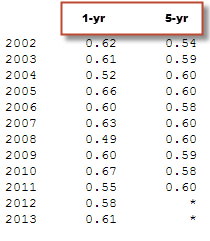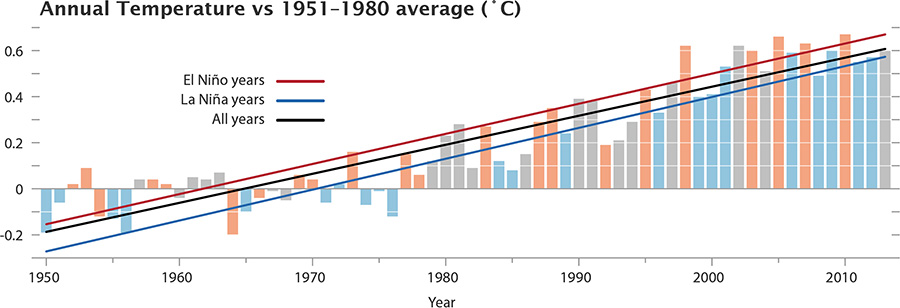In the last couple of weeks Eli has been toe-nailling about one of those incestuous ideas that creep into a bunny's mind. Something potentially very important, unnoticed, but upsetting to the normal way of thinking about the greenhouse effect. Now, let his Bunnyship get this out at the front, the idea, as the imminent readers will see, has nothing to do with the global effect, that is absolutely nailed by radiative transfer codes matched against emissions to space. And no, it is not Viscount Rabett's maundering about how there is no such thing as nasty hominids warming the planet, but to continue
Now, for some, not Eli to be sure, but maybe, Willard Tony,, the title of this post would be
Something’s happened. From now until Sunday February 30th, around Noon RRST, Rabett Run will be suspending publishing except for what Brian says and maybe John. At that time, there will be a
major announcement that I’m sure will attract a broad global interest
due to its controversial and unprecedented nature.
Media outlets be sure to check in to Rabett Run every half hour. Hits are needed
But, then again, all remember
the resulting damp squib. That and the fact that Ms. Rabett has put Eli on a carrot free diet till he loses some have perhaps deepened the hallucination.
On the other hand were Eli
Tamino he would think about his thoughts and ask others for their take
That’s what scientists do. When we don’t agree on what’s happening, we
try to understand it. If a lot of different possibilities are
investigated, well that’s the way it always happens. Eventually, we’ll
sort through which arguments are most persuasive and reach at least some
measure of agreement. That’s how science works. And it works, bitches.
As discussed above, bun fun, at least Eli's, and he is a very dull and old bunny indeed, sometimes includes thinking about usual things in different ways. About a week ago the Rabett got into it with someotherbunny who knows what he is blathering about, who uttered the usual idea that the greenhouse effect works, because emission from greenhouse molecules is isotropic, not unidirectional, certainly not in the upwards direction and stuck there
OK, let's think about this a bit Eli thought. Hmm, when you think about it the hallmark of emission and absorption from greenhouse gases is that locally (key word that) they really don't connect with each other. Absorption is driven by radiation in the right wavelength region from the ground or other greenhouse gas molecules. Emission is a function of local thermal collisional excitation. Molecules excited by absorbing a photon, thermalize that energy within a few microseconds so we need to think about where the heat energy released from collisional vibrational de-excitation flows. If the energy is localized, for example if transport is limited to diffusion which is quite slow at atmospheric pressures, then we can model emission and absorption of photons as coming from the same point in space. On the other hand, if the energy is transported a great distance before it excites a molecule which emits or hits the ground, then the process is transport limited and the direction of the emission really does not matter much.
One of the interesting things is that at say 280 ppm, the distance at which the absorption is 1/e ~ 37%, in the R branch (the bunch of lines to higher frequency, which represent transitions from rotational levels with quantum numbers j" of the ground state to those with quantum number j'=j"+1)of the CO
2 absorption is about 2 m. For the Q branch (the structure in the middle, where j"=j') the 1/e distance is about 35 cm
..
At 400 ppm, the 1/e distance in the R/Q branch is ~ 1.3/0.2 m and at 600 ppm R/Q 1/e is ~0.9/0.15 m.
For one thing this shows that the level from which emission from greenhouse gases reaches the surface is about zilch. But wait, there is more. We now have a scale for absorption height and emission rate, the inverse of the radiative lifetime of 1.1 sec for the bending mode of CO
2 at 670 cm
-1. That gives a rate of 0.9 sec
-1, call it 1 Hz. The ratio of the rate to the mixing rate is equivalent to a set of parameters called Damkohler numbers.
Damkohler numbers are ratios of reaction rates to mixing rates, handy things for ChemEs If the Damkohler number is greater than unity it means that reactions are faster than the ability to mix, and the reaction is mixing/flow controlled, and if it is less than one, then conversely the reaction is kinetically limited. To decide which is the case, we need a rate or characteristic time for thermal transport on both calm and windy days, specifically for vertical mixing.
Finding this actually turns out to be harder than you would think because folks who do fluid dynamics don't really measure this, and if they do it is as ratios to various scale lengths that are obscurely buried in obscure equations as functions of things that are obscure constants but never clearly stated. Even my modeler friend can't give a simple answer, but it is clear that a few m/s for eddy diffusion is not unreasonable near the ground and in urban canyons, which implies that the greenhouse effect in the boundary layer and maybe higher up in those huge up and downdrafts that bump planes is driven by atmospheric flow, not radiation, and that it is only in the limit of the Damkohler number going to zero (high up) that the process becomes completely radiative.
Given how good the radiative transfer codes are at predicting emission it is unlikely that this mechanism makes a global difference at the TOA, but the implications especially for high/low CO
2 situations with major eddies, like urban canyons and tree canopies, are Eli thinks potentially interesting.
Consider this a provocation.



















